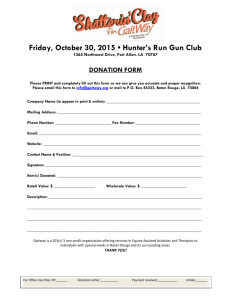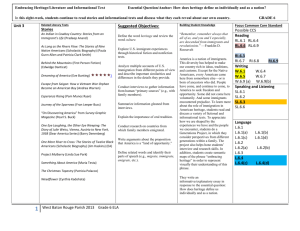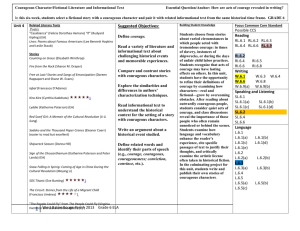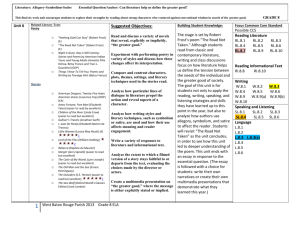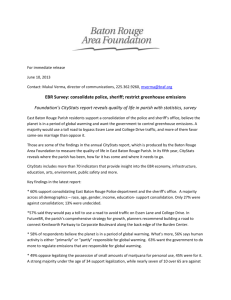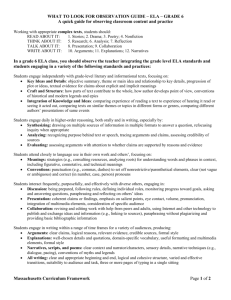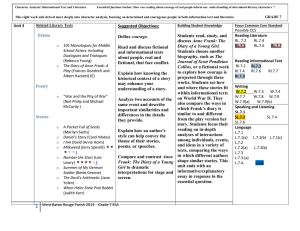CCSS Unit 2 Gr8 ELA DHenry
advertisement
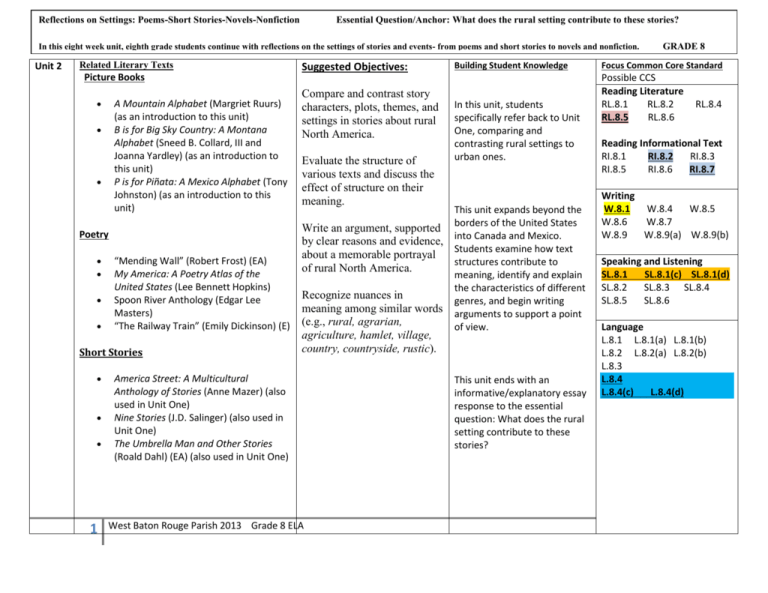
Reflections on Settings: Poems-Short Stories-Novels-Nonfiction Essential Question/Anchor: What does the rural setting contribute to these stories? In this eight week unit, eighth grade students continue with reflections on the settings of stories and events- from poems and short stories to novels and nonfiction. Unit 2 Related Literary Texts Picture Books A Mountain Alphabet (Margriet Ruurs) (as an introduction to this unit) B is for Big Sky Country: A Montana Alphabet (Sneed B. Collard, III and Joanna Yardley) (as an introduction to this unit) P is for Piñata: A Mexico Alphabet (Tony Johnston) (as an introduction to this unit) Poetry “Mending Wall” (Robert Frost) (EA) My America: A Poetry Atlas of the United States (Lee Bennett Hopkins) Spoon River Anthology (Edgar Lee Masters) “The Railway Train” (Emily Dickinson) (E) Short Stories 1 Suggested Objectives: Compare and contrast story characters, plots, themes, and settings in stories about rural North America. Evaluate the structure of various texts and discuss the effect of structure on their meaning. Write an argument, supported by clear reasons and evidence, about a memorable portrayal of rural North America. Recognize nuances in meaning among similar words (e.g., rural, agrarian, agriculture, hamlet, village, country, countryside, rustic). America Street: A Multicultural Anthology of Stories (Anne Mazer) (also used in Unit One) Nine Stories (J.D. Salinger) (also used in Unit One) The Umbrella Man and Other Stories (Roald Dahl) (EA) (also used in Unit One) West Baton Rouge Parish 2013 Grade 8 ELA Building Student Knowledge In this unit, students specifically refer back to Unit One, comparing and contrasting rural settings to urban ones. This unit expands beyond the borders of the United States into Canada and Mexico. Students examine how text structures contribute to meaning, identify and explain the characteristics of different genres, and begin writing arguments to support a point of view. This unit ends with an informative/explanatory essay response to the essential question: What does the rural setting contribute to these stories? GRADE 8 Focus Common Core Standard Possible CCS Reading Literature RL.8.1 RL.8.2 RL.8.5 RL.8.6 RL.8.4 Reading Informational Text RI.8.1 RI.8.2 RI.8.3 RI.8.5 RI.8.6 RI.8.7 Writing W.8.1 W.8.4 W.8.5 W.8.6 W.8.7 W.8.9 W.8.9(a) W.8.9(b) Speaking and Listening SL.8.1 SL.8.1(c) SL.8.1(d) SL.8.2 SL.8.3 SL.8.4 SL.8.5 SL.8.6 Language L.8.1 L.8.1(a) L.8.1(b) L.8.2 L.8.2(a) L.8.2(b) L.8.3 L.8.4 L.8.4(c) L.8.4(d) Stories Barrio Boy (Ernesto Galarza) Of Mice and Men (John Steinbeck) Roll of Thunder, Hear My Cry (Mildred D. Taylor) (E) 3 Shane (Jack Schaefer) The Adventures of Tom Sawyer (Mark Twain) (E) The Daybreakers (The Sacketts) (Louis L'Amour) The Incredible Journey (Sheila Burnford) The Land (Mildred D. Taylor) 1 The Last of the Mohicans (James Fenimore Cooper) This Land Was Made for You and Me: The Life and Songs of Woody Guthrie (Elizabeth Partridge) (E) Travels with Charley: In Search of America (John Steinbeck) (E) Informational Texts Nonfiction 2 African-Americans in the Old West (Cornerstones of Freedom Series) (Tom McGowen) California Invasive Plant Council (Invasive Plant Inventory) (E) Geeks: How Two Lost Boys Rode the Internet out of Idaho (Jon Katz) (E) Never Cry Wolf: The Amazing True Story of Life Among Arctic Wolves (Farley Mowat) One Hundred & One Beautiful Small Towns in Mexico (Guillermo Garcia Oropeza and Cristobal Garcia Sanchez) The Alamo (Cornerstones of Freedom, Second Series) (Tom McGowen) (OOP) West Baton Rouge Parish 2013 Grade 8 ELA “The Marginal World” (1955) in The Edge of the Sea (Rachel Carson) Trail of Tears (Cornerstones of Freedom Series) (Peter Benoit) Wild Horses I Have Known (Hope Ryden) (OOP) Art, Music and Media Art o o o o Unit 2: Edward Hopper, Cape Cod Evening (1939) Edward Hopper, Early Sunday Morning (1930) Edward Hopper, Gas (1940) Grant Wood, American Gothic (1930) Terminology: Explicit textual evidence Setting 3 Genre Text Structures West Baton Rouge Parish 2013 Grade 8 ELA Implicit textual evidence Travelogue Weeks 7-14 Grade 8 Unit 2 Reflections on Settings: Poems-Short Stories-Novels-Nonfiction “I CAN” Statements Standards for Unit 2 Reading Literature RL.8.1 Read closely to determine what the text says explicitly and to make logical inferences from it; cite specific textual evidence when writing or speaking to support conclusions drawn from the text. RL.8.2 Determine central ideas or themes of a text and analyze their development; summarize the key supporting details and ideas. RL.8.4 Interpret words and phrases as they are used in a text, including determining technical, connotative, and figurative meanings, and analyze how specific word choices shape meaning or tone. I can cite textual evidence to support analysis of what the text says explicitly. I can make inferences drawn from the text. I can determine a theme or central idea of a text and analyze its development over the course of the text, including its relationship to the characters, setting and plot. I can provide an objective summary of the text. I can determine the meaning of words and phrases as they are used in a text, including figurative and connotative meanings. I can analyze the impact of specific word choices on meaning and tone, including analogies or allusions to other texts. FOCUS STANDARD RL.8.5 Analyze the structure of texts, including how specific sentences, paragraphs, and larger portions of the text (e.g., a section, chapter, scene, or stanza) relate to each other and the whole. RL.8.6 Assess how point of view or purpose shapes the content and style of a text. Reading Informational Text RI.8.1 Read closely to determine what the text says explicitly and to make logical inferences from it; cite specific textual evidence when writing or speaking to support conclusions drawn from the text. 4 West Baton Rouge Parish 2013 Grade 8 ELA I can compare and contrast the structure of two or more texts. I can analyze how the differing structure of each text contributes to its meaning and style. I can analyze how differences in the points of view of the characters and the audience or reader (e.g., created through the use of dramatic irony) create such effects as suspense or humor. I can cite the textual evidence that most strongly supports an analysis of what the text says explicitly as well as inferences drawn from the text. FOCUS STANDARD RI.8.2 Determine central ideas or themes of a text and analyze their development; summarize the key supporting details and ideas. RI.8.3 Analyze how and why individuals, events, and ideas develop and interact over the course of a text. I can determine a central idea of a text and analyze its development over the course of the text, including its relationship to supporting ideas; provide an objective summary of the text. I can analyze how a text makes connections among and distinctions between individuals, ideas, or events (e.g., through comparisons, analogies, or categories). RI.8.5 Analyze the structure of texts, including how specific sentences, I can analyze in detail the structure of a specific paragraph in a text, paragraphs, and larger portions of the text (e.g., a section, chapter, including the role of particular sentences in developing and refining a scene, or stanza) relate to each other and the whole. key concept RI.8.6 Assess how point of view or purpose shapes the content and style of a I can determine an author’s point of view or purpose in a text. text. I can analyze how the author acknowledges and responds to conflicting evidence or viewpoints. FOCUS STANDARD I can evaluate the advantages and disadvantages of using different RI.8.7 Integrate and evaluate content presented in diverse media and mediums (e.g., print or digital text, video, multimedia) to present a formats, including visually and quantitatively, as well as in words. particular topic or idea. Writing FOCUS STANDARD I can write arguments to support claims with clear reasons and relevant W.8.1 Write arguments to support claims in an analysis of substantive evidence. topics or texts, using valid reasoning and relevant and sufficient evidence. I can introduce claim(s), acknowledge alternate or opposing claims, and organize the reasons and evidence logically. I can support claim(s) with logical reasoning and relevant evidence, using accurate, credible sources and demonstrating an understanding of the topic or text. I can use words, phrases, and clauses to create cohesion and clarify the relationships among claim(s), reasons, and evidence. I can establish and maintain a formal style. W.8.4 Produce clear and coherent writing in which the development, organization, and style are appropriate to task, purpose, and audience. 5 West Baton Rouge Parish 2013 Grade 8 ELA I can provide a concluding statement or section that follows from and supports the argument presented. I can produce clear and coherent writing in which the development, organization, and style are appropriate to task, purpose, and audience. W.8.5 Develop and strengthen writing as needed by planning, revising, editing, rewriting, or trying a new approach. W.8.6 Use technology, including the Internet, to produce and publish writing and to interact and collaborate with others. W.8.7 Conduct short as well as more sustained research projects based on focused questions, demonstrating understanding of the subject under investigation. W.8.9 Draw evidence from literary or informational texts to support analysis, reflection, and research. I can with some guidance and support from peers and adults, develop and strengthen writing as needed by planning, revising, editing, rewriting, or trying a new approach, focusing on how well purpose and audience have been addressed. I can use technology, including the Internet, to produce and publish writing and present the relationships between information and ideas efficiently as well as to interact and collaborate with others I can conduct short research projects to answer a question (including a self-generated question), drawing on several sources and generating additional related, focused questions that allow for multiple avenues of exploration. I can draw evidence from literary or informational texts to support analysis, reflection, and research. I can apply grade 8 Reading standards to literature (e.g., “Analyze how a modern work of fiction draws on themes, patterns of events, or character types from myths, traditional stories, or religious works such as the Bible, including describing how the material is rendered new”). I can apply grade 8 Reading standards to literary nonfiction (e.g., “Delineate and evaluate the argument and specific claims in a text, assessing whether the reasoning is sound and the evidence is relevant and sufficient; recognize when irrelevant evidence is introduced”). Speaking and Listening FOCUS STANDARD SL.8.1 Prepare for and participate effectively in a range of conversations and collaborations with diverse partners, building on others‟ ideas and expressing their own clearly and persuasively I can engage effectively in a range of collaborative discussions (one-on-one, in groups, and teacher-led) with diverse partners on grade 8 topics, texts, and issues, building on others‟ ideas and expressing their own clearly. I can come to discussions prepared, having read or researched material under study. I can explicitly draw on that preparation by referring to evidence on the topic, text, or issue to probe and reflect on ideas under discussion. 6 West Baton Rouge Parish 2013 Grade 8 ELA I can follow rules for collegial discussions and decision-making, track progress toward specific goals and deadlines, and define individual roles as needed. I can pose questions that connect the ideas of several speakers and respond to others‟ questions and comments with relevant evidence, observations, and ideas. I can acknowledge new information expressed by others, and, when warranted, qualify or justify their own views in light of the evidence presented. SL.8.2 Integrate and evaluate information presented in diverse media and formats, including visually, quantitatively, and orally. I can analyze the purpose of information presented in diverse media and formats (e.g., visually, quantitatively, orally) and evaluate the motives (e.g., social, commercial, political) behind its presentation. SL.8.3 Evaluate a speaker’s point of view, reasoning, and use of evidence and rhetoric. I can delineate a speaker’s argument and specific claims, evaluating the soundness of the reasoning and relevance and sufficiency of the evidence and identifying when irrelevant evidence is introduced. SL.8.4 Present information, findings, and supporting evidence such that listeners can follow the line of reasoning and the organization, development, and style are appropriate to task, purpose, and audience I can present claims and findings, emphasizing salient points in a focused, coherent manner with relevant evidence, sound valid reasoning, and wellchosen details; use appropriate eye contact, adequate volume, and clear pronunciation. I can integrate multimedia and visual displays into presentations to clarify information, strengthen claims and evidence, and add interest. SL.8.5 Make strategic use of digital media and visual displays of data to express information and enhance understanding of presentations. SL.8.6 Adapt speech to a variety of contexts and communicative tasks, demonstrating command of formal English when indicated or appropriate. Language L.8.1 Demonstrate command of the conventions of standard English grammar and usage when writing or speaking. I can adapt speech to a variety of contexts and tasks, demonstrating command of formal English when indicated or appropriate. I can demonstrate command of the conventions of standard English grammar and usage when writing or speaking. I can explain the function of verbals (gerunds, participles, infinitives) in general and their function in particular sentences. I can form and use verbs in the active and passive voice. I can form and use verbs in the indicative, imperative, interrogative, conditional, 7 West Baton Rouge Parish 2013 Grade 8 ELA and subjunctive mood. I can recognize and correct inappropriate shifts in verb voice and mood.* L.8.2 Demonstrate command of the conventions of standard English capitalization, punctuation, and spelling when writing. I can demonstrate command of the conventions of standard English capitalization, punctuation, and spelling when writing. I can use punctuation (comma, ellipsis, dash) to indicate a pause or break. I can use an ellipsis to indicate an omission. I can spell correctly. L.8.3 Apply knowledge of language to understand how language functions in different contexts, to make effective choices for meaning or style, and to comprehend more fully when reading or listening. FOCUS STANDARD L.8.4 Determine or clarify the meaning of unknown and multiple-meaning words and phrases by using context clues, analyzing meaningful word parts, and consulting general and specialized reference materials, as appropriate. I can use knowledge of language and its conventions when writing, speaking, reading, or listening. I can use verbs in the active and passive voice and in the conditional and subjunctive mood to achieve particular effects (e.g., emphasizing the actor or the action; expressing uncertainty or describing a state contrary to fact). I can determine or clarify the meaning of unknown and multiple-meaning words or phrases based on grade 8 reading and content, choosing flexibly from a range of strategies. I can use context (e.g., the overall meaning of a sentence or paragraph; a word‟s position or function in a sentence) as a clue to the meaning of a word or phrase. I can use common, grade-appropriate Greek or Latin affixes and roots as clues to the meaning of a word (e.g., precede, recede, secede). I can consult general and specialized reference materials (e.g., dictionaries, glossaries, thesauruses), both print and digital, to find the pronunciation of a word or determine or clarify its precise meaning or its part of speech. I can verify the preliminary determination of the meaning of a word or phrase (e.g., by checking the inferred meaning in context or in a dictionary). 8 West Baton Rouge Parish 2013 Grade 8 ELA
